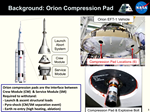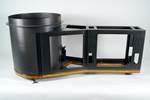Rock West Composites supports DiskSat satellite assemblies
Space-grade Strato panels line was incorporated into the small spacecraft platform’s solar array substrate/backup structure assemblies design, reducing costs, lead time and meeting positional tolerance without fixtures.
Source: Rock West Composites
Rock West Composites (RWC, San Diego, Calif., U.S.) has delivered four composite combination solar array substrate/backup structure assemblies to Aerospace Corp. (El Segundo, Calif., U.S.) in support of the DiskSat Program.
DiskSat is a NASA-funded technology demonstration program that seeks to verify the performance and deployment method of this new, small spacecraft platform. The disk-shaped satellite design has the potential to revolutionize smaller space missions through its high-power, large aperture form factor that fits in the circular cross-section of a rocket fairing. By using its own off-the-shelf, — spaceflight-ready high modulus fiber plates, sandwich panels and solar array substrates — RWC was able to significantly reduce lead time and cost, while helping define structural properties to support the mission’s innovations. If successful, follow-on missions are possible, and other prime contractors may look to use a similar form factor for volumetric and weight efficiencies.
Providing additional services for this build-to-print program, the RWC engineering team consulted on the design including layup, material selection, insert design, bonding methods and manufacturing strategy. RWC used its own product, the StratoSubstrate Leo class, to ensure a cost-effective solar array substrate. The team used an insert design that allowed for self-fixturing to a tight tolerance, avoiding a costly assembly fixture. The tolerances on the in-plane and out-of-plane inserts match to a global datum scheme, and tolerances were on the order of 0.010-0.020 inch positional.
According to the company, the use of StratoSubstrate Leo panel blanks significantly reduced raw material and blank lead time. StratoSubstrate Leo class panels use HR40/NB321 unidirectional prepreg, NB301 film adhesive, perforated aluminum honeycomb core and 0.002-inch HN Kapton. The inserts for the deliverable were BR-127 primed aluminum bonded with EA9394. The final assembly measures approximately 1 meter in diameter and 25 centimeters in thickness.
“Saving our customer cost and lead time for this program is exactly why we developed the Strato product line,” Jeremy Senne, RWC’s space segment director, says. “We are excited about the potential for this new form factor in the exploration of space.”
Related Content
-
TCR Composites introduces TR1116 snap-cure epoxy prepreg resin system
Designed for press-cure applications, the resin system is highlighted for its snap-cure capability and tailored properties.
-
Designing and manufacturing turbine test nacelles
Michigan-based Ground Test Solutions (GTS) shares the design and manufacturing processes involved in building composite nacelle components used in testing jet and helicopter engines.
-
Plant tour: Airbus, Illescas, Spain
Airbus’ Illescas facility, featuring highly automated composites processes for the A350 lower wing cover and one-piece Section 19 fuselage barrels, works toward production ramp-ups and next-generation aircraft.






